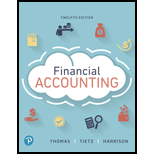
Concept explainers
The two main categories of stockholders’ equity are
- a. assets and liabilities.
- b.
retained earnings and common stock. - c. common stock and
preferred stock . - d. retained earnings and paid-in capital.
To identify: The two main categories of stockholders’ equity.
Answer to Problem 1QC
d. retained earnings and paid in capital.
Explanation of Solution
The two main categories of stockholders’ equity are paid-in capital and retained earnings which are explained below:
Paid-in capital refers to the amount paid by the investors on common stock and preferred stock issued to them.
Retained earnings refers to the amount of earnings that are not paid as dividends to the stockholders rather kept by the corporation for reinvestments, payment of debts, and future growth.
Justification for incorrect options:
“Option a” is not a correct answer, because both assets and liabilities are not the categories of stockholders’ equity. Both assets and liabilities are the components of balance sheet like stockholders’ equity.
“Option b” is partly correct; however it is not exact answer. Common stock is not a main category of stockholders’ equity, because paid in capital is the main category of stockholders’ equity, and the common stock will be reported under the category of paid in capital.
“Option c” is partly correct; however it is not an exact answer, because both common stock and preferred stock will be sub-categorized under the main category of paid in capital. Another main category of stockholders’ equity is retained earnings.
Justification for correct answer:
“Option d” is a correct answer, because both the paid in capital and retained earnings are the main categories of stockholders’ equity.
Thus, the correct answer is option d. retained earnings and paid-in capital.
Want to see more full solutions like this?
Chapter 10 Solutions
Financial Accounting (12th Edition) (What's New in Accounting)
- Please provide the solution to this general accounting question with accurate financial calculations.arrow_forwardCan you solve this general accounting problem using accurate calculation methods?arrow_forwardI am looking for help with this general accounting question using proper accounting standards.arrow_forward
- Can you solve this general accounting question with the appropriate accounting analysis techniques?arrow_forwardPlease provide the answer to this general accounting question with proper steps.arrow_forwardCan you help me solve this general accounting question using valid accounting techniques?arrow_forward
- I am trying to find the accurate solution to this general accounting problem with the correct explanation.arrow_forwardCan you explain this general accounting question using accurate calculation methods?arrow_forwardI need help with this general accounting problem using proper accounting guidelines.arrow_forward
 Cornerstones of Financial AccountingAccountingISBN:9781337690881Author:Jay Rich, Jeff JonesPublisher:Cengage LearningPrinciples of Accounting Volume 1AccountingISBN:9781947172685Author:OpenStaxPublisher:OpenStax College
Cornerstones of Financial AccountingAccountingISBN:9781337690881Author:Jay Rich, Jeff JonesPublisher:Cengage LearningPrinciples of Accounting Volume 1AccountingISBN:9781947172685Author:OpenStaxPublisher:OpenStax College

